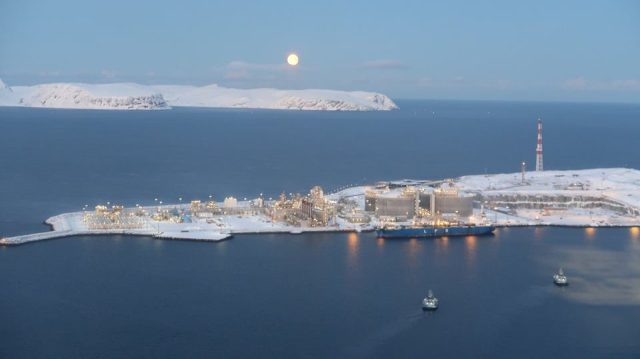The collapse of Norway’s Labour-Center government coalition last week has already sparked a new battle over energy supplies to the country’s lucrative but climate unfriendly gas processing plant on the Arctic island of Melkøya. The Center Party had gone along with plans to electrify the plant with cables from the mainland, in order to reduce its carbon emissions, but is now backing out.
 Norway’s gas processing facility on Melkøya, an island off Northern Norway’s Arctic coast at Hammerfest, has always been controversial from a climate and environmental standpoint. Now debate is erupting once again over how to cut its substantial carbon emissions by replacing its own gas power plant. Various options are expensive and can create other problems. PHOTO: OED
Norway’s gas processing facility on Melkøya, an island off Northern Norway’s Arctic coast at Hammerfest, has always been controversial from a climate and environmental standpoint. Now debate is erupting once again over how to cut its substantial carbon emissions by replacing its own gas power plant. Various options are expensive and can create other problems. PHOTO: OED
Center Party leader Trygve Slagsvold Vedum admitted on Monday that his earlier support for electrification, when he was still finance minister, was wrong. “We lost on that issue while in the government,” Vedum said Monday morning during an appearance on NRK’s political debate program Politisk kvarter. He tried to explain why he’d reluctantly gone along with Labour’s plans to electrify Melkøya, adding “that was a mistake.”
Now, free of restraints and the need for compromise for the sake of government unity, Vedum and several other parties are mounting a new battle over how the important Melkøya facility should be powered. Instead of bringing in electricity from the mainland, Vedum, his party and the right-wing Progress Party want to let state oil and energy company Equinor just keep using its gas power plant despite all the emissions it spews out.
 Trygve Slagsvold Vedum was part of the government coalition between his Center Party and Labour that approved and launched plans to electrify Melkøya in 2023. Now he’s leaving the government and his post as finance minister, and changing his mind on the issue. PHOTO: NRK screen grab
Trygve Slagsvold Vedum was part of the government coalition between his Center Party and Labour that approved and launched plans to electrify Melkøya in 2023. Now he’s leaving the government and his post as finance minister, and changing his mind on the issue. PHOTO: NRK screen grab
They argue that bringing in electricity from the mainland is too expensive, will pull too much of Northern Norway’s electricity supply and raise electricity rates for residents of Finnmark and Troms. Progress leader Sylvi Listhaug told newspaper VG that she wants to “halt the electricity robbery that’s now planned for Northern Norway.”
Both the Reds and Socialist Left parties also want to halt the electrification project, but for different reasons. The Reds claim to be most concerned about how the huge overhead power lines would scar the landscape while the wind power turbines needed to generate more electricity would disturb reindeer herding in the area for the native Sami people. The Socialist Left doesn’t want new electricity cables or turbines either, but is pushing instead for construction of an expensive carbon capture and storage facility to cut emissions from Melkøya’s gas power plant.
Terje Aasland, Labour’s survivng energy minister, doesn’t think it’s possible to halt the electrification process now, claiming that it’s “much too late.” During the debate on NRK Monday morning, he noted how “contracts are signed” and the government’s “power promises” to all of Finnmark would be broken. “This is about much more than Melkøya,” he said.
His Labour government’s “power promises” remain, however, highly controversial among the Sami and both state and local taxpayers. Adequate electricity production would rely on wind power and more controversial turbines towering over the landscape, damaging nature and angering the Sami. The plans were pushed through just after the state was already in conflict with the Sami over wind turbines on the Fosen peninsula in Troms, whice led to massive demonstrations in Oslo and, finally, a government apology for violations of the Sami’s human rights.
Aasland, however, stresses how Norway needs to move over to more renewable energy, with wind power high on the list despite its offensive turbines. Not only would more turbines in Finnmark supply more renewable energy, they would help cut as much as a million tons of CO2 in sensitive Arctic areas.
Vedum is still hoping that a new majority in Parliament could halt the electrification plans for Melkøya. His potential partners want to also push through carbon capture and support on the island. Halting the electrification could also help Vedum’s struggling Center Party win back voters in Northern Norway before the next national election in September.
More than anything it shows how quickly last week’s coalition government’s collapse can affect major issues as Labour goes it alone with just 26.3 percent of the vote. It will constantly need to win support from other parties in its new minority government due to debut on Tuesday.
NewsinEnglish.no/Nina Berglund